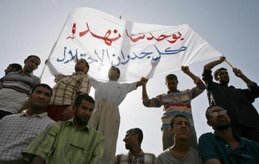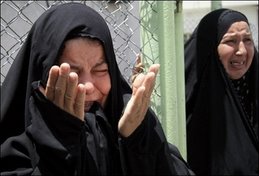World Bank: 44% Of Iraqis Earn Less Than $83 A Month
AMMAN (Dow Jones)--Some 44% of Iraqis received a monthly income of less than 100,000 Iraqi dinars ($85), or less than $2.7 a day, according to a study unveiled Sunday by the World Bank and the Iraqi Ministry of Planning.
The study, called 'Iraq Socio-Economic Survey', shows that a considerable percentage of people in Iraq still live in poverty despite the fact that Iraq possesses the world's third-largest oil reserves.
The World Bank study, carried out during the last two years, said unemployment among Iraqis who are able to work has now reached 12%.
Researchers also found out that some 15% of Iraqi children didn't enroll in the country's primary schools and some 63% didn't enroll in intermediate schools, while 79% didn't enroll in secondary schools during the academic year 2007-2008.
It's the first ever comprehensive study carried out since the U.S.-led war that ousted the government of Saddam Hussein almost six years ago, organizers said.
Years of sanctions and wars have impacted the living standards of Iraq's population of around 30 million people.
The $7 million survey, financed by the World Bank, highlights significant variations in living standards among Iraqis across the country. It said out of the 18,144 families surveyed in all Iraqi provinces, some 25% earned a monthly income of less than IQD500,000 ($425), while some 6% of them earned IQD2 million ($1,702). According to the study, the average Iraqi family consists of 6.9 people.
The study isn't only focused on Iraqis' incomes, but also takes into account access to basic services such as electricity and water, followed by health and education.
It said only 12.5% of the population seems to enjoy a stable water supply, although that more than 80% of individuals live in dwellings connected to public water networks.
As for electricity, the national grid is the main source of three-quarters of the population, but provides an average of only eight hours a day. As such, citizens revert to the costly generators for backup, it said.
Concerning health, it found out that some 3% of the surveyed families suffered from bad health, consequences as a result of kidnapping or receiving life threats caused by violence. Some 10% of them suffer from chronic conditions such as diabetes and high blood pressure.
Researchers said the situation was also aggravated by the deteriorating security situation in Iraq especially during the years 2006 and 2007.
"A quarter century ago, Iraq was the most developed in the Middle East...Regrettably, political instability, wars, sanctions have taken their toll on its institutions as well as citizens, undermining living standards and pushing the population into a vicious circle of fear and misery," said Hedi Larbi, World Bank Middle East director.
The head of Iraq's Central Organization for Statistics, Mehdi Al Alak said that his office and the World Bank would publish figures on the exact percentage of poverty in Iraq at the end of February. "Poverty in Iraq is less than 44%," he told Dow Jones Newswires.
"Of course there is poverty in Iraq," said Susan Razzaz, World Bank's Project's Task Team Leader. She said the Iraqi government would soon identify for the first time a line for poverty in Iraq.
This study will be an important addition to the toolkit of policy makers, development planners and practitioners, said an Iraqi member of the parliament who attended the event









